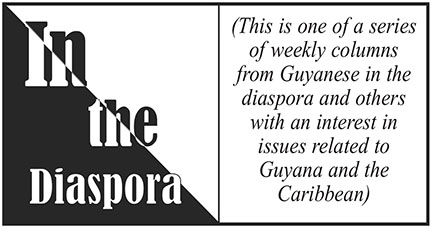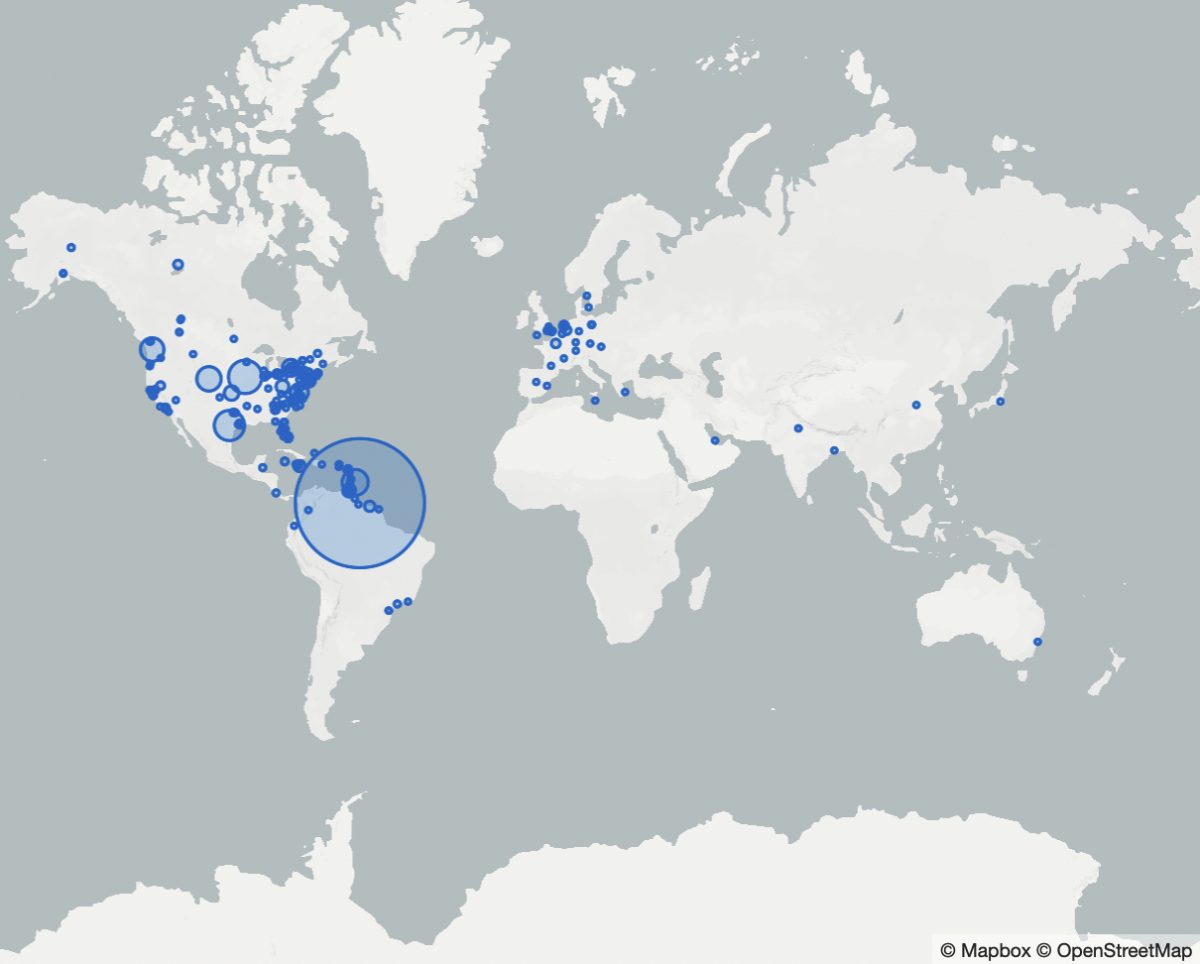 By Adrienne Rooney, Ramaesh J. Bhagirat-Rivera, Vibert Compton Cambridge
By Adrienne Rooney, Ramaesh J. Bhagirat-Rivera, Vibert Compton Cambridge
Adrienne Rooney is a Ph.D. Candidate in Art History at Rice University writing a dissertation on Carifesta. Ramaesh J. Bhagirat-Rivera, Ph.D., is a Caribbean historian and Assistant Professor of Critical Mixed-Race Studies in the Department of Asian and Asian American Studies at Binghamton University. Vibert Compton Cambridge, A.A., Ph.D., is Professor Emeritus in the School of Media Arts and Studies, Scripps College of Communication, Ohio University.
In this column, the organizers of the international symposium to commemorate the 50th anniversary of the inaugural Caribbean Festival of Arts (Carifesta) held in Guyana, share some of our initial reflections and thinking behind the symposium.
To begin, we would like to join Ms. Ave Brewster-Haynes, President of the Guyana Cultural Association of New York, Inc., in expressing sincere thanks to the partners, participants, and attendees who contributed to the successful presentation of the August 5 to 7 virtual symposium The Inaugural Caribbean Festival of Arts as Prism: 20th Century Festivals in the Multilingual Caribbean. In the three weeks since the gathering, we have reflected on the generous, poignant, cathartic conversations and co-discovery that transpired within the space of the forum, and we will continue to do so for the foreseeable future.
Carifesta ’72 took place from August 25 to September 15, 1972.
Today— August 29—fifty years ago, Guyanese newspaper headlines rang out: “It was a grand night of dancing at QC,” “Surinamers praise concept of Carifesta,” “Cuban, Haitian clash at ‘literary’ talks,” “Carifesta evolution and revolution,” relayed the Guyana Graphic. “Appreciation for Cumfa,” articulated the Evening Post. “PM 3 hours at art exhibition,” “5-nation culture show thrills sell-out crowd,” “Carifesta: Chance for Caribbean unity,” announced The Daily Chronicle.
These headlines reveal the richness of revelation, debate, and celebration that unfolded across the festival, which was also haunted by ethnic tension, as headlines on other days made clear.
On August 29, Michael Gilkes’ play Couvade, which premiered on the festival’s opening night, had its final performance at the Theatre Guild (for the remaining two weeks of the festival, the Guild would present The Maids, Unchained, and Smile Orange—plays from the U.S. Virgin Islands, Barbados, and Jamaica, respectively).
If they had already seen Couvade, that evening Carifesta visitors could have attended a performance by artists including Viva Bahia from Brazil, Javanese dancers from Suriname, or Louise “Miss Lou” Bennet from Jamaica. Maybe as they waited in line to enter the venues (Queen’s College or the partly constructed Cultural Centre), visitors chatted about one of the many art exhibitions they could have seen earlier in the day: the 500+ work International Art Exhibition on view at Bishops’ High School, the Child Art Exhibition on view at St. Joseph’s High School, the Photographic Exhibition on view at St. George’s School, or solo shows by Guyanese artists Stanley Greaves, Aubrey Williams, or Philip Moore at the Freemason’s Hall, in the case of the former, and Critchlow Labour College, in the case of Williams and Moore. August 29, fifty years ago, was packed with eye opening, multisensory possibility.
Many of the events just mentioned came up during The Inaugural Caribbean Festival of Arts as Prism—held as part of the 2022 Guyana Folk Festival—which we envisioned as an opportunity for an intergenerational exploration of the origins, events, experiences, missteps, legacies, and stories of Carifesta ’72. You can see for yourself how the conversations transpired for a few more days on Facebook (the symposium’s Livestream recording will be available through early September) or in the future Digital Archive of Guyanese and Caribbean Festivals, Culture (discussed below). The symposium’s seventeen sessions featuring artists, archivists, scholars, activists, and policy makers took place nearly entirely online. Please visit: https://www.facebook.com/guyfolkfest/videos for access to the recordings.
We elected to hold the symposium virtually from the start—in part because of the volatility of Covid-19 when we started planning it, but equally, if not more so, because we saw the benefits of the virtual space. Over the past two years, as the pandemic familiarized many with online events, we had each independently relished an upsurge in online lectures, interviews, and film festivals concerning post-colonial Caribbean experiences. Creators of this content include agencies such as the Barbados Museum and Historical Society, Guyana Speaks, the Indo-Caribbean Society in Guyana, Indo-Caribbean Cultural Centre in Trinidad, the Moray House Trust, University of Guyana, UWI TV, among others. These online engagements were intergenerational, participatory in practice and global in scope. They represented a continuity in Caribbean intellectual life—the engagement of the public intellectual and the community in reflecting on history and envisioning preferred futures. We wanted the symposium to be a forum for conversations that needed to cross geographic boundaries, and we hoped it would be of interest to a wider public with a variety of income levels and access to travel. With these factors in mind, the virtual space held the most potential.
After all, Carifesta itself was designed to be an international affair for a region with shared histories due to mass migration—forced or elected—and intersecting diasporas. How could we root a symposium in one location when people from so many places lived through Carifesta ’72, were impacted by it, held its memories (from celebratory to painful) close? The map above shows how geographically wide conversations on Carifesta can be.
As scholars with varying relationships to Carifesta, we knew that despite the festival’s mark on the Caribbean and its diaspora and its familiarity in popular circles, it held a counterintuitively marginal place in scholarship. Yet we also knew that a new generation of interdisciplinary researchers, policy makers, and creatives were examining the Carifesta experience and practice in the context of the Caribbean creative landscape. We wanted to see what might happen when many of them came together with people who had experienced the inaugural festival personally. Further, what vibrations, resonances, and dissonances would come to the fore, we wondered, when thinking about Carifesta ’72 alongside other festivals across the multilingual region? Given our multilingual vision—in keeping with Carifesta’s vision of course—we translated the call for participation into the major European language groups within the Caribbean and Latin America. If we had the budget, we would have translated the call into as many Caribbean Creole languages as possible. The entire symposium would have been live translated into all of these languages, Creole and European alike—this would have been in and of itself revolutionary. We did not have the tens of thousands of dollars to realize this, though we dream of a well-funded regional organization to help organizers of all sorts to achieve this emancipatory goal.
What we lacked in budget we made up for in a true richness of partnership. Given the reach of the Guyanese and Caribbean communities, our partners were located both in Caribbean homelands and diasporic spaces. In Guyana, our partners were the University of Guyana, Moray House Trust, Lions Club of Ruimveldt, and Festival City 50th Anniversary Celebrations Committee. The Caribbean Broadcasting Union was a regional partner. In the United Kingdom, Guyana Speaks was a partner. In the United States, along with the Guyana Cultural Association of New York, Inc, the other partners were the academic institutions where the organizers are based: Rice University, Binghamton University, and Ohio University.
The partnerships we initiated are indicative of our organizing philosophy. In addition to seeking partners across the Atlantic World, we aimed to work with a mix of academic and community-based organizations to emphasize the multiple ways in which knowledge is accumulated and shared. Universities are of course but one forum in which the production of knowledge takes place. Community organizations are equally important spaces for knowledge production—for sharing information, for building narratives of self, culture, memory, history, and for envisioning futures. We wanted to create a digital forum that represented a breadth of ways of knowing, learning, and communicating: from the community and academy, from spoken word to written, from visual languages to embodied practices.
Additionally, we aimed to connect with non-partisan organizations actively involved in shaping cultural and intellectual discourse for a public beyond the academy. We felt that the forum created by the symposium needed to be open to debate unburdened by the heavy arm of partisan politics. The international partnership developed to organize and present the symposium represents a model that is replicable and one that we recommend. Of course, partisan politics could not be fully avoided and ignored. For instance, we were conscious not to replicate colors directly associated with Guyanese political parties. Ever conscious of the polysemic (many meanings) associations with the colors red, green, yellow, and purple in Guyanese society, we avoided using them in a dominant mode or altered the hues.
From the outset, moreover, we hoped the symposium would be just the start of a conversation, and that it might catalyze further programs, debate and, especially and crucially, preservation in a non-extractive manner. Talking about Carifesta ‘72, other festivals, and forms of cultural expression more broadly calls for thinking about how related materials are preserved and shared. In conversation with the Caribbean Research Library at the University of Guyana, we determined to create a space to gather archival materials and oral histories for posterity, a collection that would help foster sustainable conversation. The Digital Archive of Guyanese and Caribbean Festivals, Culture and Literature at the University of Guyana’s Caribbean Research Library (CRL), which was launched at the symposium, is the embodiment of this commitment. According to Mrs. Gwyneth George, AA, Librarian of the University of Guyana Library, and Ms. Syndrene Harris, Acting Head of the Caribbean Research Library, the Archive will be developed as an inclusive, world-class, “one-stop-shop”—a digital hub for the study of Guyanese and Caribbean cultural experiences. In addition to holding the CRL’s sizeable collection of related materials and official recordings of the symposium, the Archive will grow through a number of voluntary initiatives that will continuously engage the communities of Guyana, the Caribbean, and its diasporas.
Through a process of co-discovery, we aim to hear the stories of local elders through our oral history collection, read about their memories through our online recollections page, and reference the cultural mementos and artifacts that have been preserved in personal collections, whether in archival boxes or shoeboxes. The CRL’s own collection of Carifesta materials was on view in Carifesta@50: The Festival City Exhibition, a cornerstone of the symposium’s single in-person event, which was held at the Den of the Lions Club of Ruimveldt in Festival City. Festival City in North Ruimveldt was the home for many of the delegations that came to Guyana for Carifesta ’72. Festival City is where festival participants stayed, talked, ate, and formed community. Festival City is a legacy of Carifesta ’72.
The event marked the first donation to the Archive as well as the inauguration of its oral histories project. Collectively, the three-day symposium was viewed over 24,000 times, and we hope that some of those who tuned in—or those who did not—will join us in building this invaluable resource for the public and researchers alike.
In the next column we will share more about particular aspects of our experience and our thoughts on key takeaways from the symposium, which you can learn more about at carifestaat50.com.

